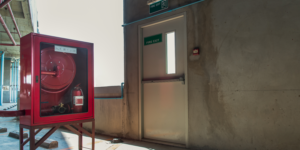Active safety measures like residential fire sprinkler systems help prevent fire-related injuries, deaths, and property damage. These systems are common in new homes, but many older ones lack them. Retrofitting residential fire sprinkler systems is a wise safety investment, but it costs and requires care. This tutorial covers the pros, drawbacks, and crucial factors of retrofitting a domestic fire sprinkler system.
Understanding Residential Fire Sprinkler Systems
A household fire sprinkler system detects and extinguishes fires in homes. Fire departments do not control these systems, which respond instantly. There are two main residential fire sprinkler systems:
Wet Pipe Systems: The most popular house system has water in the pipes at all times.
Dry Pipe Systems: These systems use pressurized air or nitrogen to keep water out of the pipes until a fire activates the system.
The Benefits of Retrofitting a Residential Fire Sprinkler System
Retrofitting a residential fire sprinkler system offers several important benefits:
Fire Protection: The top benefit is improved fire protection. These systems often contain and extinguish fires before they spread, reducing damage and risk.
Life Safety: A fire sprinkler system gives inhabitants more time to escape a fire, minimizing the chance of injury or death.
Property Protection: Fire sprinklers can prevent extensive property damage by controlling fires early in their development. This can reduce the cost of repairs and insurance claims.
Lower Insurance Premiums: Many insurance companies offer discounts on homeowners’ insurance for properties with fire sprinkler systems due to the reduced risk of fire damage.
Increased Property Value: A home with a fire sprinkler system may have a higher resale value and appeal to safety-conscious buyers.
Costs of Retrofitting a Residential Fire Sprinkler System
While beneficial, updating a house fire sprinkler system costs money. Several factors affect costs, including:
Property Size: Larger homes will require more sprinklers and piping, resulting in higher installation costs.
Type of System: The choice between a wet pipe or dry pipe system can impact the cost, with dry pipe systems generally being more expensive.
Accessibility: The ease of access to the areas where the sprinkler system will be installed can influence costs. For example, homes with crawl spaces or limited access may require additional labor.
Building Design: Complex architectural designs or structures may necessitate more customized and costly installation.
Local Building Codes: Compliance with local building codes and regulations is essential and can affect the cost. Some areas may require additional safety features or inspections.
Water Supply: The availability and capacity of the water supply can affect the cost, as some properties may need modifications to their water supply infrastructure.

Important Considerations
Before retrofitting a domestic fire sprinkler system, homeowners should consider:
Local Regulations: Check local building laws and authorities to see if a retrofit is allowed and what criteria apply.
Aesthetics: Unobtrusive fire sprinklers can affect your home’s appearance. Consider how the system will complement your interior decor and if you like the look.
Maintenance: Fire sprinkler systems require periodic maintenance to ensure they function properly. This includes testing and inspections, which can add to the long-term cost.
Water Supply: Confirm that your property’s water supply meets the necessary requirements for a fire sprinkler system. Inadequate water supply may necessitate costly modifications.
Professional Installation: It’s crucial to hire a qualified and certified professional to design and install your residential fire sprinkler system. Cutting corners on installation can compromise safety.
Insurance Considerations: While fire sprinklers can reduce insurance premiums, discuss the specifics with your insurance provider to understand the potential cost savings.
Integration with Alarms: Consider integrating your fire sprinkler system with smoke alarms and fire alarm systems for added safety and early warning.
Environmental Considerations
Fire sprinkler systems are generally environmentally friendly in the following ways:
Water Efficiency: Fire sprinkler systems use less water than fire department hoses, reducing water waste and potential water damage.
Green Building Practices: Installing a fire sprinkler system aligns with green building practices and sustainability efforts, as it contributes to reducing fire-related waste and emissions.
Reduced Smoke and Chemical Release: Fire sprinklers can help control fires before they reach a stage where they release large amounts of smoke and toxic chemicals into the environment.
Conclusion
Retrofitting a domestic fire sprinkler system protects your property and its residents. The benefits of fire protection, life safety, property protection, and potential insurance savings make this approach a good choice for many homeowners, despite the expense. Before starting, examine local rules, contact an expert, and make sure the retrofit fits your property’s water supply and building architecture. Finally, a house fire sprinkler system provides invaluable peace of mind and security.
